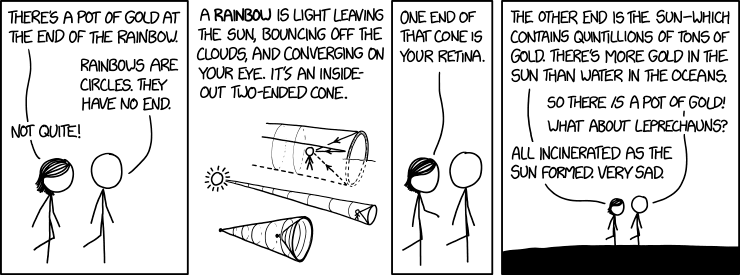Rainbow connection
Published:
My most impressionable memory of seeing a rainbow happened in a tourist bus in Iceland. It was faint, like a watercolour painting on the canvas that was the pale blue sky and the treeless Icelandic landscape. I noticed it first, and a few minutes later the whole bus was teetering at one side of the bus, peering spellbound out of the window (except for the bus driver, I hope).
All of us under its spell, we know that it's probably magic
Have you been half asleep?
And have you heard voices?
I've heard them calling my name
Is this the sweet sound
That called the young sailors?
The voice might be one and the same
Suggested background music: The Muppet Movie – Rainbow Connection
Why are there so many songs about rainbows
And what's on the other side?
This post has actually been simmering in my mind since I read this paper [1], a review about rainbows in a physics journal! I was amazed by 1) how nice it is to have a comprehensive physical explanation of an everyday object in a journal article, 2) how complex the physics of rainbows is, and 3) potentially how much we don’t know still about rainbows. It is such a formidable task to bring together the physics and fascination and wonder, and package it into a neat, coherent post. Here goes!
Rainbows are intangible, in the sense that they are nothing more than scattered sunlight reaching the observer from certain directions, or, alternatively expressed, they are heavily distorted images of the Sun itself.
– Alexander Haußmann, in the review article [1]
The physics of rainbows can be very succinctly stated: rainbows are projections of light refracted by water droplets, perceived by you, the observer. Now, that brief physics of rainbows have a lot of mind-blowing implications:
Rainbows are visions
But only illusions
And rainbows have nothing to hide
They are optical illusions, since you need to be at certain angle with respect to the sunbeam and the water droplets.
This means that you can’t get your hands on the leprechaun’s gold pot at the end of the rainbow; nor can you cross over to Asgård via the rainbow bridge Bifröst to say hej to Odin/Thor/Loki. (Somewhere, someone is wearing a T-shirt saying “Science: ruining romance since 12xx”). But then again …

Obligatory xkcd comic
Image credit: xkcd
- The xkcd comic above already mentions it: the rainbow is not a semicircle, it’s a full circle. Most of the time we observe from too low an altitude that we don’t see the other half.
What's so amazing
That keeps us stargazing
And what do we think we might see
Back to optical illusion: For the same reason, rainbow has no true mirror image! “…[T]he raindrops that contribute to the mirrored rainbows are located at a different position than those that make the direct bows” [1].
You’ve located intrinsic worth in the wrong place,” she said to all of them, over the common band. “It’s like a rainbow. Without an observer at a twenty-three-degree angle to the light reflecting off a cloud of spherical droplets, there is no rainbow. The whole universe is like that. Our spirits stand at twenty-three-degree angle to the universe. There is some new thing created at the contact of photon and retina, some space created between rock and mind. Without mind there is no intrinsic worth.”
– Kim Stanley Robinson, Blue Mars- Another observer at slightly different position doesn’t see the same rainbow. They would see refractions from another droplet that fits the angle at their position.
- The light does not have to be from the sun, it can be from the moon (moonbow).
So we've been told
And some choose to believe it
I know they're wrong, wait and see
- If the droplet is small (e.g. in fog), the colours would not be well-separated, and you would see white rainbow (fogbow). Check out this article <What the heck are white rainbows, and where do they come from?>.
- Raindrops are not spherical due to air drag. But the small ones experience less air drag such that they are roughly spherical. Bigger ones oscillate so much that “no stable rainbows are formed”. [1]
- The droplet does not have to be raindrop, it can be your garden-variety garden hose spray, for instance.
Who said that every wish
Would be heard and answered
When wished on the morning star
Somebody thought of that
And someone believed it
And look what it's done so far
- The droplet does not have to be raindrop, it can be ice crystals. I once saw a cousin of the rainbow, polar stratospheric cloud, in the Swedish Lapland. The iridiscence comes from diffraction by ice crystals, so one only sees this when the temperature is very low (it was around -20°C as I recall). See this article for more atmospheric optical phenomena.

Polar stratospheric cloud that I saw
I've heard it too many times to ignore it
It's something that I'm supposed to be
Someday we'll find it
The rainbow connection
The lovers, the dreamers and me
So, the next time it rains, look, look for that distorted image of the Sun, that only exists at the interface of photon and retina.
Some more nice articles:
There Is More to a Rainbow than Meets the Eye
Rainbows are (literally) in the eye of the beholder
Check out the review article as well:
[1] Rainbows in nature: recent advances in observation and theory (2016) Alexander Haußmann Eur. J. Phys. 37 063001

Leave a Comment
Your email address will not be published. Required fields are marked *